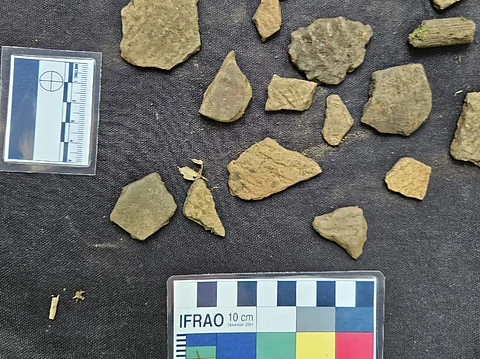
- Home
- Live Blog
- Breaking News
- Top Headlines
- Cities
- NE News
- Sentinel Media
- Sports
- Education
- Jobs

Our Correspondent
Haflong: Neolithic tools and cord-marked pottery pieces used by early humans were discovered on the surface during a field visit to the ridges of Daojali Hading in the Langting-Mupa Reserve, located in the Dima Hasao district of Assam, informed Dr Shring Dao Langthasa, Research Archaeologist, Department of Archaeology, Dima Hasao on Thursday.
Daojali Hading is a significant archaeological site in Northeast India, renowned for its Neolithic settlements. The site first gained attention in the 1960s when ancient artefacts were unearthed during the construction of the Lumding-Haflong road. This discovery prompted further exploration and study by anthropologists and archaeologists, leading to a deeper understanding of the region’s Neolithic history and its place in the broader narrative of the Indian subcontinent.
Excavations conducted by the Department of Anthropology, Gauhati University in 1962-63 revealed a 45 cm deep layer containing Neolithic tools and coarse, poorly fired pottery. These findings were pivotal in placing the North-Eastern Region (NER) on the Neolithic map of the country, providing valuable insights into the lifestyle and practices of the region’s jhum (shifting) cultivators. The tools and pottery unearthed at Daojali Hading offered evidence of early human habitation and technological development, shedding light on the subsistence strategies and cultural practices of the Neolithic communities in the area.
The Neolithic history in Dima Hasao was characterized by using polished stone tools, such as axes, adzes, and chisels, which were essential for clearing forests and practising rudimentary agriculture. The cord-marked pottery, often coarse and poorly fired, indicates early attempts at pottery-making, likely used for storage and cooking purposes. Cord-marked pottery is a defining characteristic of Neolithic cultures in Southeast Asia. Discoveries at Daojali Hading have extended the known boundary of this Neolithic tradition into the NER. These findings provide crucial evidence of cultural transitions and cross-cultural interactions in the ancient world, highlighting the movement of technologies, traditions, and communities across regions. Moreover, these artefacts reflect the transition from a nomadic, hunter-gatherer lifestyle to a more settled, agrarian way of life.
Recent advancements in dating techniques, particularly thermoluminescence dating of pottery fragments in 2017 have pushed the estimated age of the site to 2.7 ± 0.3 ka (LD1728), which is 2700 Before Present. This new evidence confirms that early humans inhabited Dima Hasao for thousands of years, establishing it as an area of significant historical and archaeological importance. The revised dating not only extends the timeline of human occupation in the region but also underscores the enduring significance of Daojali Hading as a key site for understanding the Neolithic history in the NER. The practice of jhum cultivation, which involves clearing land by burning and rotating fields to allow soil regeneration, is believed to have its roots in this cultural period and continues to be practised by indigenous communities in the region today.
In addition to the Neolithic practices, the Dima Hasao district is also known for its Megalithic traditions, which represent a later phase of ancient cultural development. Megalithic practices in the region are characterised by the construction of large stone structures, such as monolithic jars, dolmens, menhirs, and stone circles, which were often used as burial sites or memorials. These structures, typically made of locally available stones, reflect the community’s reverence for their ancestors and their beliefs in an afterlife.
The coexistence of Neolithic and Megalithic practices in Dima Hasao underscores the region’s importance as a cultural and historical crossroads. The Neolithic phase laid the foundation for settled agricultural communities, while the Megalithic tradition marked the emergence of more complex social structures and ritualistic practices. Together, these phases provide a comprehensive understanding of the region’s ancient past and its contribution to the broader narrative of human development.
The discoveries at Daojali Hading and other sites in Dima Hasao continue to contribute to the broader narrative of human history in the Indian subcontinent, highlighting the region’s role in the development of early agricultural practices, settlement patterns, and cultural traditions. The site remains a focal point for ongoing research, offering a window into the lives of the early inhabitants of the NER and their adaptation to the environment over millennia.
As more archaeological investigations are conducted, further insights will likely be gained into the Neolithic and Megalithic practices of the region, enriching our understanding of the diverse history of Dima Hasao and its people, Dr Langthasa added.
Also Read: Assam: Hojai student achieves 1st zonal rank in International Mathematics Olympiad
Also Watch: